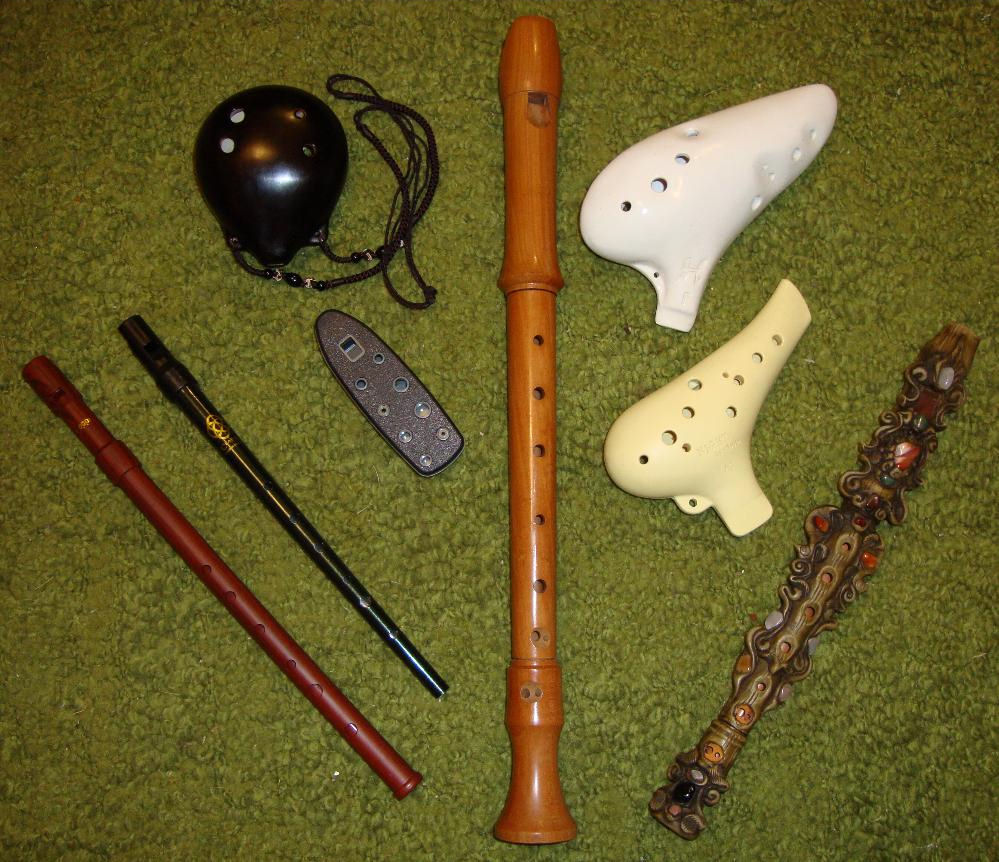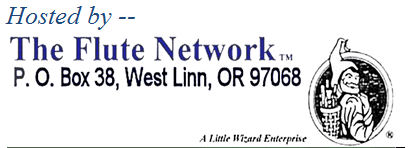

Folk Flutes: Ocarinas, Recorders, Tin Whistles, and Native American Flutes
My previous
article discussed inexpensive
plastic flutes: tonettes, song flutes, flutophones,
and precorders. Those pre-band instruments are ideal for
introducing children to music. They fit small hands and are easy
to play. What makes them interesting is that they've also become
popular folk instruments. So many have grown up playing them in
school that they've become legitimate tools of musical expression.
Millions enjoy them.
Today we'll look at four popular folk flutes: ocarinas, recorders,
tin whistles, and Native American flutes. We'll answer basic
questions about each. Which are easiest to learn? Appropriate for
which kinds of music? What are their strengths and shortcomings?
How do you get started with them? I'll provide simple answers.
All these flutes are fipple
flutes -- you blow into a
mouthpiece that directs your breath to make sound. That makes them
much easier to get started with than traditional concert flutes or
their wood equivalents, bamboo flutes. You won't spend days
learning how to blow into the mouthpiece just to play a few notes.
Folk flutes are easy, inexpensive, and portable. There are tons of
how-to videos and free sheet music on the web.
If
you play the concert flute, folk flutes are a fun way to expand
your horizons. You'll be playing songs as soon as you pick one up.
If you don't play an instrument, folk flutes are the perfect place
to start. That's also why they're excellent teaching tools for
kids. Let us take a close look at ocarinas, recorders, tin
whistles, and Native American flutes.
Ocarinas
Ocarinas are vessel
flutes: flutes that voice
based on the resonance of sound waves within a closed air chamber.
They do not have open-ended bores as do most other flutes. This
gives them a unique sound.
Ocarinas date back thousands of years to the ancient Chinese and
Mesoamerican civilizations. Italian Giuseppe Donati invented the
modern oc in the 1850s. He standardized the instrument so that it
could play western scales with simple fingering.
Ocarinas are typically made of ceramic clay, plastic, or sometimes
wood. They come in many shapes but categorize into three: transverse,
inline, and pendant.
The
photo below shows two transverse oc's on the left, two rectangular
inlines in the middle, and two round pendants on the right:
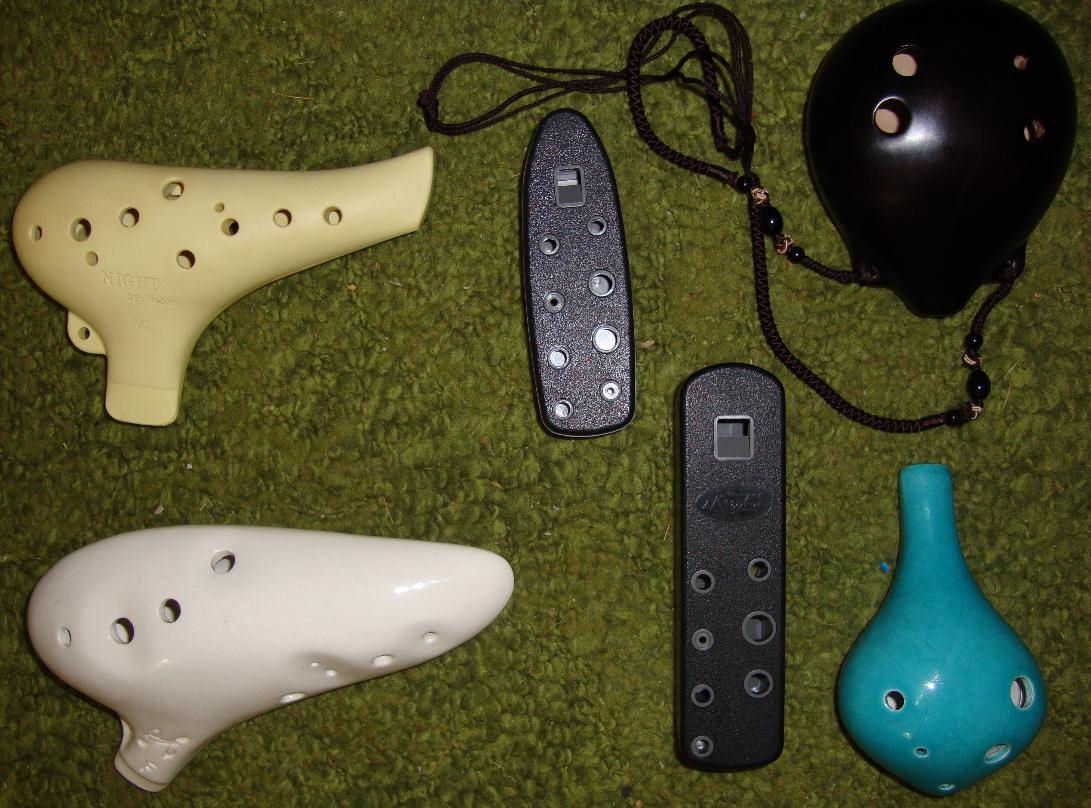
The
bigger the oc, the lower its pitch. Bigger also means quieter and
more expensive. Small oc's can be pretty loud, so sometimes people
buy larger ones so as not to disturb others.
You finger
transverse and inline oc's in the same way. (As folk instruments,
different brands of ocarinas sometimes have very minor fingering
differences.) The main difference with inlines is their shape.
They're rectangular and extend straight out from your mouth when
you play them.
The two round pendants on the right side of the photo have only 4
holes on top plus two thumb holes beneath. (Some pendants don't
even have the thumb holes.) Pendants have an entirely different
fingering system than the transverse/inline system. They're called
pendants because most have attached necklaces so that you can wear
them around your neck, like the black oc in the photo. Pendants
are also known as seedpods.
Beware of pendants that aren't playable. There's a whole universe
of decorative oc's -- many from Latin America -- that make dandy
keepsakes but are not playable instruments. You can spot them
because all their top holes are the same size. The holes in a
playable pendant vary in size.
Which oc's are easiest to learn? Transverse/inline fingering is
more intuitive. You progressively
lift
your fingers off the holes to ascend
the scale, just as you do with concert flutes, recorders, tin
whistles, and Native American flutes. You play sharps and flats by
cross-fingering.
Most oc players start with a transverse Alto C. Some choose
plastic because it's more durable and won't break or chip if
knocked about. Others favor the more rounded tones of ceramic.
Plastic or ceramic, oc's start at $10 USD. Good ones cost only $20
to $40. Be sure to read reviews before you buy. Listen to a sound
sample, too. These are folk instruments, so be careful: some
are not well tuned. My own recommendations
appear in the table at the end of
this article.
Let's listen to some ocarinas. To get you in the mood, here's an inspiring
piece
by a professional. (The musician
plays a multichamber oc, an ocarina with more than one air
chamber that enables a greater pitch range than normal
single-chamber oc's. It's tough for beginners, unfortunately.) A
better bet is the transverse Alto C I mentioned earlier. Here's a demo
of the very popular plastic Focalink
Alto
C that retails for about $27 USD,
and here's a review
of a ceramic alto C from OcarinaWind that goes for $23 USD. Focalink
and OcarinaWind
products both boast excellent Amazon
ratings.
So why is the ocarina considered a folk rather than a concert
instrument? Its pitch range is limited at only 10 to 13 whole
notes. Orchestral instruments span 2 1/2 to 3 octaves. And you
can't tune the oc. So it's not always suitable for ensembles.
Ocarinas are incredibly easy to learn. Even beginners can produce
their captivating sound. If you play concert flute, you will be
playing songs the moment you pick one up.
You can get started for only $20 or $30 USD. Everything beyond the oc itself -- lessons, tutorials, sheet music, advice, and more -- is free on the internet. If you've never played an instrument before or just love their exquisite voice, try an oc.
Youtube channels -- David Erik
Ramos Kissing88
STL
Ocarina
Free sheet music -- 12holeOcarina
Pinterest
STLOcarina
Ocarina Song Book
Product reviews --
The Ocarina Network's
online forum and
Amazon's customer product reviews
Community -- The
Ocarina
Network's Facebook group
Reddit ocarina
community
OcarinaTabs
(tabular notation for those who don't read music)
Recorders
Recorders are end-blown flutes that trace their ancestry
back to medieval Europe. When classical composers wrote for
"flute" before the 19th century, they were often referring to what
we today call the recorder. The modern metal concert flute wasn't
perfected until the mid-1800s.
Like ocarinas, recorders feature simple fingering for whole notes.
The most common fingering system is called baroque
or English fingering.
Recorders come in standard sizes like sopranino, soprano, alto,
tenor, and bass. As with ocarinas, the bigger instruments are both
lower-pitched and quieter. This presents an advantage if loudness
is a concern where you play. Bigger also means more expensive. The
tenor in a company's line will cost more than its alto and much
more than its soprano.
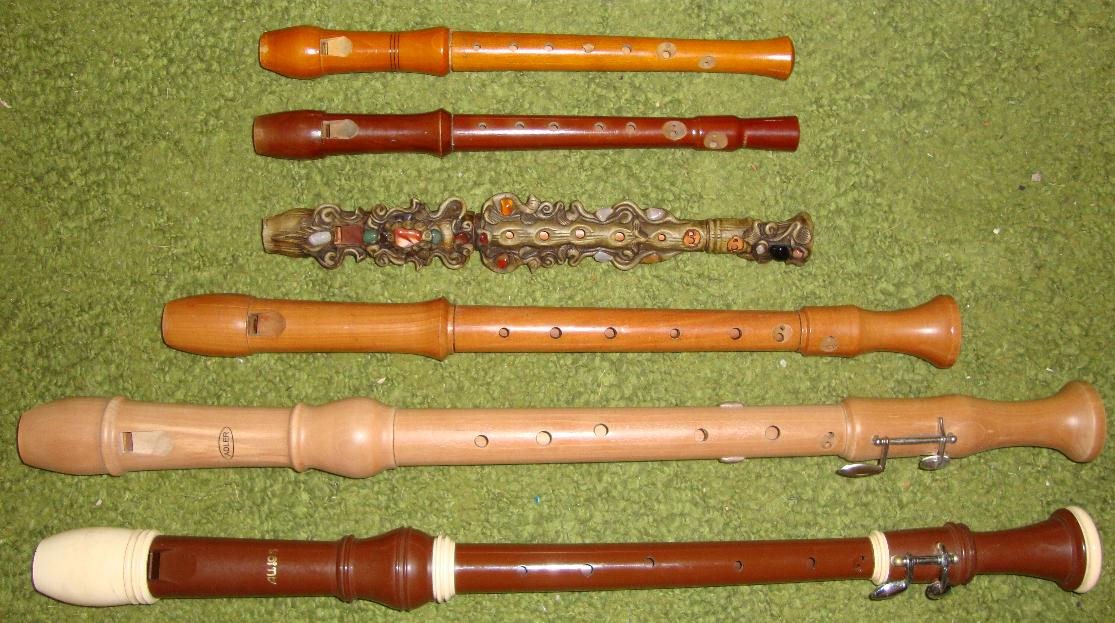
Top to Bottom: Two Pearwood Sopranos, Decorated Ceramic
Soprano,
(photo
by the author)
Maple Alto, Maple Tenor, and Plastic Tenor
Wood is the traditional material for recorders. It's more
expensive, with prices ranging from $30
to
$90 USD on the low end, up to
hundreds for the mid-range and thousands for the top instruments.
The less expensive ones are factory produced from woods like
pearwood or maple. Craftsman create the more expensive ones from
specialty woods. Keep in mind that price alone doesn't determine
quality. Sound is subjective and personal taste differs. That's
why I recommend starting with plastic and buying a wood recorder
only after you have the knowledge and experience to know what you
want.
In contrast to ocarinas and Native American flutes, recorders are
tunable. Most consist of either two or three pieces. You tune the
instrument by moving the mouthpiece in or out. This is a big
advantage in group playing. Along with all the available music, it
makes the recorder the superior choice for duets, trios, and
quartets.
Let's listen to a few sound samples. In case you've never heard a
recorder ensemble, here's a
quintet playing Greensleeves. This
solo performer demonstrates
the
soprano on several classical pieces.
That's a $45
plastic instrument he's playing so
don't let anyone tell you that you have to spend hundreds on an
expensive wood recorder! Here's how the sweet
alto sounds.
With its tunability and two-octave range, the recorder offers
ensemble fun and musical possibilities beyond those of many other
folk instruments.
-- Recorder Information --
Youtube channels -- Sarah Jeffrey's fun
Youtube channel "You
Can Play It" tutorials
Product reviews -- Amazon's
top-rated recorders (by customers)
Tutorials -- You Can Play It
Squeaky's
Recorder Playhouse (for kids)
Community -- American Recorder
Society website Reddit recorder
community Facebook
group
Facebook
Society of Recorder Players
Facebook Am. Recorder Society
Free
sheet music -- 8Notes Capotasto
Music Solo
Recorder links
to many sources
Tin Whistle
The
modern whistle is a much more recent invention. Only in the 19th
century did it standardize in its present form. The instrument's
forte is traditional Irish, Scottish, and Celtic music. But it's
versatile enough to play any genre you wish.
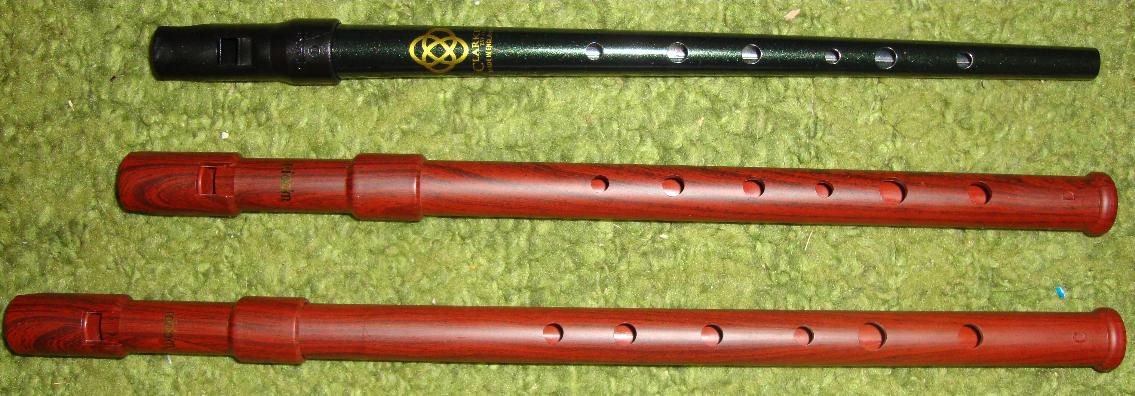
Youtube channels -- CutiePie
(aka
Stephanie) Online
Academy
of Irish Music
Beginner tips -- The
Whistle Shop
Also - Learn Tin Whistle - Lessons
Community -- Chiff
and Fipple forum Reddit
whistle community Facebook
Tin Whistle Irish Pub
Facebook Tin
Whistles
Free sheet music -- Irish-Folk-Songs.com
WhistleTabs
TinWhistler
8Notes
Learn Tin Whistle
Native American Flute
Historically, Native Americans comprised a diverse
group of related peoples with different languages and cultures
spread over a vast geographic area. They invented many kinds of
flutes and developed varieties of each. The Native American flute
gives you access to this unique musical tradition.
What we call the Native American flute today is the result of a
standardization process that occurred in the 1980s. This evolution
brought Native American flutes closer to conformance with European
musical concepts. For example, base pitches were standardized and
the pentatonic
minor
scale, a five note scale,
became predominant. This led to an explosion of interest in Native
American flutes.
Take a look at these flutes:
Most
Native American flutes are keyed to the pentatonic minor scale.
This gives them their unique sound. Practiced players can play other scales,
too. The range of the instrument varies from 1
to 1 1/3 octaves. With some flutes
you attain the highest notes by overblowing
(just as with the tin whistle).
Native American flutes are diatonic instruments. Fingering whole
notes is simple. Just progressively lift your fingers for higher
notes. Sharps and flats are
possible but fingering
varies across flutes.
These flutes are crafted in every
imaginable key. G is most popular.
People are often attracted to the sounds of even lower-pitched
flutes, but not everyone can reach their key holes. So if you want
to buy an F#, F, or lower flute, make sure you can comfortably
reach all the holes first! Most experts advise beginners to start
with a six-holed flute in A, G, F# or maybe F. Listen to these sound samples
to determine which pitch appeals to you. Of course, you'll also
want to listen to any specific flute before you buy it.
Native American flutes are produced from woods like cedar, walnut,
juniper, redwood, cherry or other more exotic choices. As with
recorders, wood density affects tone (though not so much, perhaps,
as the flute's
design
parameters.) Coloring often depends
on staining techniques more than the wood used. Given that the
instruments are handmade, prices reflect labor costs. As with wood
recorders, many cost several hundred dollars. However, there are
excellent flutes available for under $100 USD, as my
recommendations show.
You might also consider a plastic flute. Plastic is more durable and could be preferable if you play your flute outdoors or travel with it. Some excellent plastic flutes retail for only $60 USD.
How do Native American flutes sound? You've probably heard them as background to TV shows or films involving Native Americans. This soothing music attracts tens of millions of fans on Youtube. Here's an example of Native American "sleep music", and here's an album by the superb Carlos Nakai.
Part of the fun of the Native American Flute is socializing with
other players in flute
circles. You can share your
interest and learn together. Search this
list and this
one to find a circle near you.
The Native American flute is incredibly easy to play due to its
five-note scale. All the notes sound pleasing together, so you
simply can't hit a wrong one. That's the big draw to this
instrument. You can express yourself with it even if you lack
musical training.
Youtube channels -- OldManYow
SkyRedHawk
Clint Goss
Beginner tips and background
-- Flute Tree Foundation
Ancient Territories
Encyclopedia -- Flutopedia
Community -- Facebook
Native American Flute
Facebook
NAFlute Facebook
Native American Flute 2
Free sheet music -- Flutopedia Song Book
Pinterest
FluteTree
Song Book
Ocarinas
follow close on. If you can blow, you can elicit their soulful
tones. Their limited range means you need learn few fingerings.
Tin whistles and recorders are easy for beginners to start with,
too. But if you wish to explore all their possibilities, they
require more effort. Whistlers sometimes progress into fast Irish
tunes with fancy ornamentation. Some recorder players tackle
ambitious classical music.
In the end, the old saw applies to each of these folk flutes: It's
easy to learn but takes a lifetime to master.
You can get started with any these folk flutes for only $20 or $30
USD. Native American flutes are the exception, with their entry
price of $60 to $100 USD. All other resources for these
instruments are free on the web -- tutorials, sheet music,
how-to's, peer advice, instructional videos, and more.
So what are waiting for? Grab a folk flute and begin your
musical journey!
My Recommendations
Here are popular, inexpensive flutes for beginners.
They're easy to start with and sound lovely.
| Transverse Ocarinas: |
Recorders: | Tin Whistles: | Native American Flutes: |
|
| Plastic: |
Alto
C -- |
Soprano
-- |
Woodi in
D and C or Dixon D Tunable * |
Northern Spirit Flutes |
| Ceramic: |
Alto
C -- |
----- | ----- | ----- |
| Metal: | ----- | ----- | Clarke Sweetone in D | ----- |
| Wood: | Hind |
Soprano
-- |
----- | Laughing
Crow or Gray Fox Flutes or Blue Bear Flutes |
| Transverse Ocarinas: |
Recorders: | Tin Whistles: | Native American Flutes: |
|
| Range: | Varies,
most 10 to 13 notes * |
About
two octaves |
About
two octaves |
Pentatonic, 1 to 1 1/3 octaves |
| Holes on top: | 8 to 10 | 7 ** | 6 | 5 or 6 |
| Thumb holes: | 2 | 1 | 0 | 0 |
| Price: | $10 on up | $10 on up | $10 on up | $80 on up |
| Common Materials: |
plastic,
clay (wood) |
plastic,
wood |
various metals (plastic, wood) |
wood (plastic) |
| Tunable: | no | yes | varies | no |
| Sharps and Flats: |
yes | yes | Usually
considered diatonic but yes with half-holing |
Usually
considered diatonic but most chromatics are possible *** |
| Overblowing? | no | no | yes | on
some flutes for a few high notes |
|
Exceptional |
Popular
tunes, folk music |
Classical music |
Irish,
Scottish, Celtic music |
Native
American music |
* Multichamber
ocarinas contain more than one sound
chamber. This allows for a much wider pitch range. They require
greater playing skill and cost more.
** Double holes count as 1 with recorders.
*** See this discussion on
scales and tuning.
